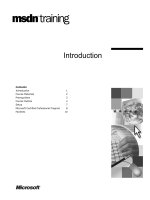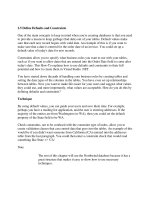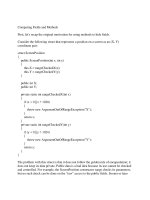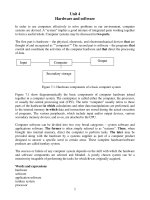Tài liệu ASIAN CRISIS AND CONSEQUENCES pptx
Bạn đang xem bản rút gọn của tài liệu. Xem và tải ngay bản đầy đủ của tài liệu tại đây (56.45 KB, 13 trang )
ASIAN CRISIS
AND
CONSEQUENCES
SM71.9005 Country Risk Management
Asian Institute of Technology
Instructor
Dr. Henry Bouchet
By
Aurelien GOUTORBE 103780
Thoppil Sanju Thomas 103857
Somchoke Visuthiratsopon 103913
Hebli Sneha Vadiraj 104002
Ruethairat Sureephong 104019
INTRODUCTION
The financial crisis which began in July 1997 in Thailand and affected currencies, stock
markets, and other asset prices in several Asian countries, many considered East Asian
Tigers. Growth rates in these countries which were in excess of five percent before 1997,
turned sharply negative in 1998 and, at the time of this writing it is not yet clear when
these economies will turn the corner and resume positive rates of growth. This report
examines how "the Asian miracle" became the “Asian Meltdown”. This paper will
analyze the different key factors that caused the crisis.
In the recent years the main causes of financial crisis have been sometimes different.
Some crises may be caused by macroeconomic imbalances, such as large budget deficits
caused by overly expansionary fiscal policies. That was, for example the case in for the
Argentina financial crisis in 2001. Some crisis may be caused by volatile capital flows.
This case for the East Asian financial crisis of 1997–1998 as will explain this report.
The economic crisis in Asia unfolded against the backdrop of several decades of
outstanding economic performance. Annual GDP growth in the ASEAN-5 (Indonesia,
Malaysia, the Philippines, Singapore, and Thailand) averaged close to 8 percent over the
last decade. Moreover, during the 30 years proceeding the crisis per capita income levels
had increased tenfold in Korea, fivefold in Thailand, and fourfold in Malaysia. Indeed,
per capita income levels in Hong Kong and Singapore now exceed those in some Western
industrial countries. And until the current crisis, Asia attracted almost half of total capital
inflows to developing countries—nearly $100 billion in 1996.
THE ACCESS TO THE ASIAN MIRACLE
The Asian tigers achieved high growth mainly due to private domestic investment and
rapidly growing human capital. High levels of domestic financial savings sustained the
countries’ high investment levels. While the agricultural sector was decreasing in
importance, it experienced rapid growth and productivity improvement. The population
growth rates were declining more rapidly than in other parts of the developing world. An
efficient system of public administration and a better educated labor force helped also the
start of this impressive economical growth. Macroeconomic management was unusually
good and macroeconomic performance unusually stable, providing the essential
framework for private investment. The policies to increase the integrity of the banking
system and to make it more accessible to nontraditional savers raised the levels of
financial savings. With a focus on primary and secondary schools, the education policies
generated rapid increases in labor force skills.
Government intervention
In most of these economies the government intervened to boost development, and in
some cases the development of specific industries. The governments used multiple,
shifting policy instruments in pursuit of more straightforward economic objectives such
as macroeconomic stability, rapid export growth, and high savings.
The government interventions took many forms:
Policies to bolster savings, build strong financial markets, and promote
investment with equity included keeping deposit rates low and maintaining
ceilings on borrowing rates to increase profits and retained earnings, establishing
and financially supporting government banks, and sharing information widely
between public and private sectors.
Policies to encourage private investment:
o Tax, tariff, and exchange rate policies to keep the price of investment
goods low
o Subsidized interest rates for corporate investment
o Policies to limit risk for private investors.
Policies to protect domestic import substitutes support declining industries, and
establishing firm- and industry-specific export targets.
Especially in Indonesia, Malaysia, and Thailand government interventions played a much
less prominent and frequently less constructive role in economic success. These
economies' capacity to administer and implement specific interventions may have been
less than in northeast Asia.
Investment, human capital, and productivity
The Asian tiger also differ from other developing economies in three factors usually
associated with economic growth:
Elevated rates of investment, exceeding 20 percent of GDP on average between
1960 and 1990, including remarkably high rates of private investment, combined
Rising endowments of human capital because of universal basic education
The best productivity growth. This performance comes from the combination of
success at allocating capital to high-yielding investments and success at catching
up technologically to the industrial economies.
The Asian government benefited from respecting and applying the fundamentals well:
encouraging macroeconomic stability, basic education, sound and solvent financial
institutions, secure property rights and complementary public investments in
infrastructure, and low relative prices of investment goods.
THE ASIAN CRISIS
Until 1997, Asia attracted almost half of total capital inflow to developing
countries. The economies of Southeast Asia in particular maintained high interest
rates attractive to foreign investors looking for a high rate of return. As a result
the region's economies received a large inflow of hot money and experienced a
dramatic run-up in asset prices.
At the same time, the regional economies of Thailand, Malaysia, Indonesia, the
Philippines, Singapore, and South Korea experienced high, 8-12 percent GDP
growth rates in the late 1980sand early 1990s.
This achievement was broadly acclaimed by economic institutions including the
IMF and World Bank, and was known as part of the Asian economic miracle.
Triggered by events in Latin America, particularly after the Mexican peso crisis
of 1994, Western investors lost confidence in securities in East Asia and began to
pull money out, creating a snowball effect.
At the time Thailand, Indonesia and South Korea had large private current
account deficits and the maintenance of pegged exchange rates encouraged
external borrowing and led to excessive exposure to foreign exchange risk in both
the financial and corporate sectors.
As the U.S. economy recovered from a recession in the early 1990s, the U.S.
Federal Reserve Bank under Alan Greenspan began to raise U.S. interest rates to
head off inflation. This made the U.S. a more attractive investment destination
relative to Southeast Asia, which had attracted hot money flows through high
short-term interest rates, and raised the value of the U.S. dollar, to which many
Southeast Asian nations' currencies were pegged, thus making their exports less
competitive.
The foreign ministers of the ASEAN countries believed that the well co-ordinated
manipulation of currencies was a deliberate attempt to destabilize the ASEAN
economies.
Malaysian Prime Minister Mahathir Mohamad accused currency speculator
George Sorosof ruining Malaysia's economy with massive currency speculation
At the 30th ASEAN Ministerial Meeting held in SubangJaya, Malaysiathey issued
a joint declaration on 25 July 1997 expressing serious concern and called for
further intensification of ASEAN's cooperation to safeguard and promote
ASEAN's interest in this regard.
Coincidentally, the Central Bankers of most of the affected countries were at the
EMEAP (Executive Meeting of East Asia Pacific) meeting in Shanghai, and they
failed to make the New Arrangement to Borrow operational.
A year earlier, the finance ministers of these same countries had attended the 3rd
APEC finance ministers meeting in Kyoto, Japan on 17 March 1996, and
according to that joint declaration, they had been unable to double the amounts
available under the General Agreement to Borrow and the Emergency Finance
Mechanism.
EFFECTS IN EACH COUNTRY
Thailand
Exchange rate: Baht per U.S. DollarFrom 1985 to 1995, Thailand's economy grew at an
average of 9%. On 14 May and 15 May 1997, the baht, the local currency, was hit by
massive speculative attacks. On 30 June, Prime Minister Chavalit Yongchaiyudh said that
he would not devalue the baht, but Thailand's administration eventually floated the local
currency, on 2 July. Some have claimed that future Thai Prime Minister Thaksin
Shinawatra was behind the devaluation.
In 1996, an American hedge fund had already sold $400 million of the Thai currency.
From 1985 until 2 July 1997, the baht was pegged at 25 to the dollar. The baht dropped
very swiftly and lost half of its value. The baht reached its lowest point of 56 to the dollar
in January 1998. The Thai stock market dropped 75% in 1997. Finance One, the largest
Thai finance company collapsed. On 11 August, the IMF unveiled a rescue package for
Thailand with more than 16 billion dollars. The IMF approved on 20 August, another
bailout package of 3.9 billion dollars.
Philippines
The Philippines central bank raised interest rates by 1.75 percentage points in May 1997
and again by 2 points on 19 June. Thailand triggered the crisis on 2 July. On 3 July, the
Philippines central bank was forced to intervene heavily to defend the peso, raising the
overnight rate from 15 %to 24 % The peso fell significantly, from 26 pesos per dollar at
the start of the crisis, to 38 pesos in 2000, to 40 pesos by the end of the crisis.
During the tenure of former President Joseph Estrada, the Philippine economy recovered
from a contraction of .6 %in GDP during the worst part of the crisis to GDP growth of
some 3 %by 2001. Unfortunately, scandals rocked his administration in 2001, most
notably the "jueteng" scandal, became a significant factor to calls for his ouster which
caused significant falls in the share prices of companies listed on the Philippine Stock
Exchange. The PSE Composite Index, the main index of the PSE, fell to some 1000
points from a high of some 3000 points in 1997. The peso fell even further, trading from
levels of about 35 pesos to 50 pesos. Later that year, he was impeached but was not voted
out of office. Massive protests caused EDSA II, which led to his resignation and lifted
Gloria Macapagal-Arroyo to the Philippine presidency. Arroyo did manage to end the
crisis in the Philippines, which led to the recovery of the Philippine peso to about 45
pesos by the time Arroyo became as the president
Hong Kong
The collapse of the Thai baht on July 2, 1997, came 24 hours after the United Kingdom
handed over soveriegnty over Hong Kong to the People's Republic of China. In October
1997, the HK dollar, which was pegged at 7.8 to the US dollar, came under speculative
pressure since Hong Kong's inflation rate was significantly higher than that of the US for
years. Monetary authorities spent more than US$1 billion to defend the local currency.
Since Hong Kong has more than US$80 billion of foreign reserves, which is equivalent to









